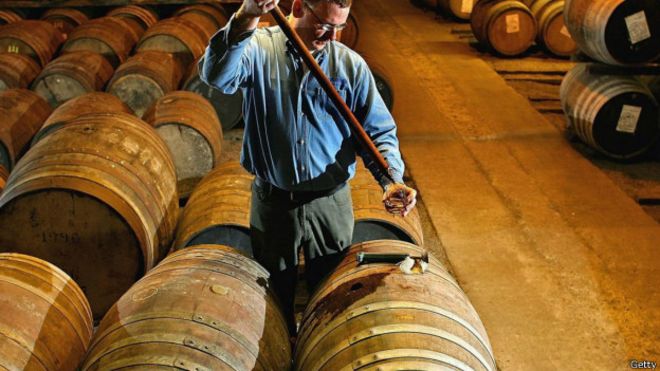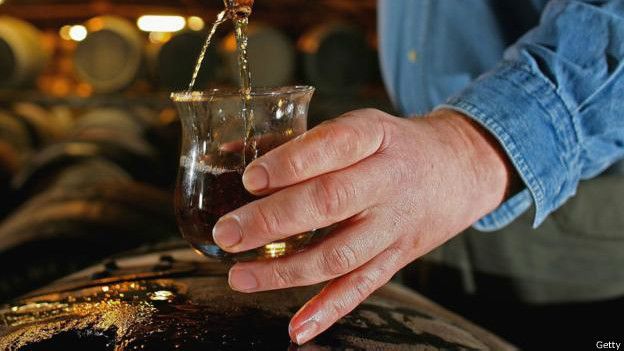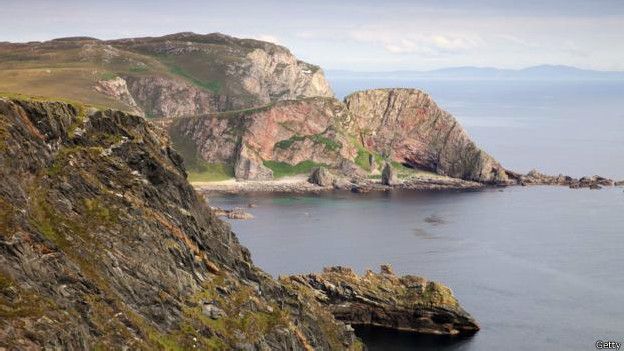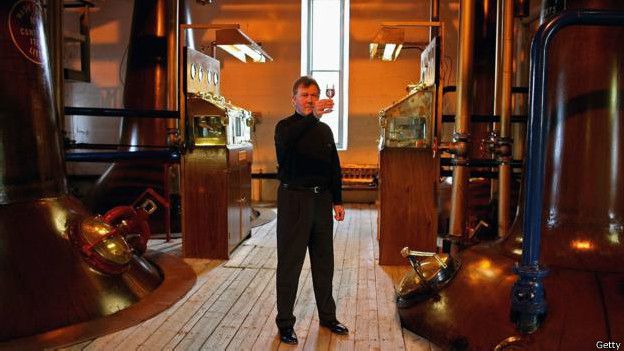喝苏格兰威士忌“绝对不该加冰块”
BBC布拉德·科恩(Brad Cohen)(2016年4月1日)

布鲁莱迪,酿酒厂,非烟熏味的威士忌,苏格兰艾雷岛,麦芽酒
第一次品尝苏格兰威士忌的时候,我还是个穷学生,躺在英国最高的本尼维斯山(Ben Nevis)山脚下的帐篷外,直接对着瓶子将 3 英镑的威士忌喝了个精光。那是在我吃了通心粉和奶酪罐头之后,当时我几乎没有意识到这是世界上最受推崇的威士忌,实在应该仔细品尝一下。于是我决定,下次回苏格兰时,不论付出什么代价,也一定要多多品尝苏格兰最好的威士忌,而且要去酒厂喝最纯正的。

喀利多尼亚运河(Caledonian Canal)入口,背后是本尼维斯山(Ben Nevis)
但结果是,我只用微笑和竖起的右手大拇指就得到了想要的一切。
我喝的第一种苏格兰威士忌是调和酒。当然,我之前一直不了解纯麦芽威士忌和调和威士忌的区别,直到八年后我回到苏格兰;而许多人至今仍然不了解。调和威士忌是由多个酿酒厂的麦芽-威士忌和谷类威士忌调和而成的。现在市面上 80% 的威士忌都是调和威士忌,品牌包括 Johnnie Walker 和 Dewars。纯麦芽威士忌则是由同一家酿酒厂用纯麦芽制作的,虽然全世界都称之为苏格兰威士忌,但苏格兰酒友却不这么叫,他们常常称其为“麦芽酒”。

在布鲁莱迪(Bruichladdich)酿酒厂从木桶中提取威士忌样本。
纯麦芽威士忌并不一定比调和威士忌好,但苏格兰最负盛名和最贵的威士忌大多都是前者。调和威士忌口感更为细腻、更易饮用;纯麦芽威士忌味道辛辣,喝的时候需要慢慢下咽。
绝大多数麦芽酒来自三大威士忌产地,即苏格兰北部的苏格兰高地(The Highlands)、苏格兰东北部的斯佩塞(Speyside)以及艾雷岛(Islay)。苏格兰高地和斯佩塞交通便利,从各大城市很容易前往,这两处产地生产的威士忌口感细腻、芳香、柔和,对于初尝麦芽酒的人来说比较容易接受。
艾雷岛(Islay)是内赫布里底群岛(Inner Hebrides)最南端的小岛,距北爱尔兰海岸约 32 公里,距格拉斯哥的直线距离大约为 113 公里。要想从格拉斯哥到达艾雷岛,需要先驱车 2.5 小时到达肯纳奎格镇(Kennacraig),然后再转乘近三小时的渡轮才能最后抵达,而且这还要在一切都顺利的情况下。当然,您也可以选择乘飞机,艾雷岛上其实有一个小机场。但与艾雷岛的交通情况相比,很多人觉得艾雷岛的威士忌更加令人难以接受。

艾雷岛崎岖不平的海岸
不过,如果您是麦芽酒的资深酒友,您的酒柜中很有可能就会有艾雷岛的麦芽酒。另一方面,如果在第一次尝试苏格兰威士忌后,您并不喜欢,觉得它烟熏味太浓,或者感觉它有药味或者烟灰缸的味道,这种威士忌很可能就是艾雷岛产的。
艾雷岛威士忌的这种独特口感来自烧泥炭的烟味,原因是,制作这种威士忌的大麦麦芽是用泥炭烘干的,而苏格兰人长久以来都靠烧泥炭为房屋供暖。人们对此的反应截然不同:一些纯粹主义者认为泥炭让威士忌失去原味,另外一些人却痴迷这种口感,不断寻找烟熏味更浓的威士忌。
不同酒厂使用的泥炭量差别很大。布莱迪 (Bruichladdich) 是艾雷岛上唯一生产非烟熏味威士忌的酿酒厂,而艾雷岛另一端的拉弗格 (Laphroaig) 生产的则是泥炭味道最浓的威士忌,这种威士忌喝下去,不折不扣全是泥炭的味道。拉弗格最近开展的“欢迎提意见”活动收到了一些反馈,内容各种各样,有“味道像是在涂满焦油的渔船上大嚼,也有“像是在喝古董店里的东西”。而与我的感受最相近的是:“感觉像是在与一个泥炭沼泽中的怪物打架,双方打着打着突然停下了,看着彼此的眼睛,然后就亲了起来。”
葡萄酒的酒友喜欢谈论风土条件:即赋予葡萄酒(以及制作葡萄酒的葡萄)独特口味的环境、地质和地理条件。但品鉴葡萄酒需要有内行的犀利,才能通过盲品就了解葡萄酒的确切产地。威士忌却不一样,即便是业余爱好者,粗尝一口,大致也能分清楚这酒是否产自艾雷岛。

推着一桶布鲁莱迪威士忌酒的工人。
我喝过的酒中,还没有别的酒能像艾雷岛威士忌一样打下如此之深的原产地烙印。这种威士忌尝起来真的就像艾雷岛一样,有覆盖全岛的泥炭沼泽味道,也有在漫长看不到头的冬天取暖时的烟火味,还有海水的咸腥味。
艾雷岛没有什么是容易的。岛上崎岖难行,海风猛烈,无休无止。成串的白色建筑组成波摩(Bowmore)和波特爱伦(Port Ellen)两个主要村庄;剩下的地方大多都是绵羊和鸟儿的栖息地,大部分都被泥炭所覆盖。泥炭沼泽经过数千年才能形成,需要有完美的风暴席卷整个小岛。
艾雷岛长 25 英里,公共交通糟糕犹如噩梦,驱车走访酿酒厂根本行不通。所以在艾雷岛的三天,我伸出拇指,一路搭着当地热情居民的便车,沿着海风吹袭的海岸,挨个造访了热情好客的八个酿酒厂,尝遍烟熏味道浓淡不一的各种威士忌。
对我而言,酿酒厂是一个近乎神秘的地方,这里将炼金术和科学结合在一起,创造了远比二者简单相加更伟大的东西。这里还是一个气味博物馆,每个房间的气味都美妙而独特。
走访苏格兰酿酒厂还是一笔物超所值的交易。一般花 5 到 7 英镑,您就能造访一家酿酒厂,喝上一小杯威士忌,或者两杯未兑水的桶装原酒威士忌。许多酿酒厂还提供稍贵一些的仓库品酒活动,最多花 25 英镑,您就能直接品尝木桶中的稀有威士忌,包括一些在其他地方买也买不到的威士忌,还有您以后可能再也尝不到的威士忌。

布鲁莱迪酿酒厂的吉姆·麦克尤恩(Jim McEwan)举着一杯经四次蒸馏的纯麦芽威士忌酒新品样本。
我最喜欢的仓库品酒体验还是在拉弗格 (Lagavulin)。当时,我花了 12 英镑,加上“经典麦芽酒之友(Friends of the Classic Malts)”赠券,品尝了桶藏八年、还不适合装瓶的威士忌,那种难喝的味道让我切实领略了在木桶中多藏几年对于威士忌是多么重要。我还尝了一下二次熟成的酒(也就是在波本酒桶中藏了 16 年,还未在雪利酒桶中熟成的酒)以及 30 年的麦芽酒。如果您能在酒吧中找到后者,价格一般都是 50 多欧元一杯,因为大部分纯麦芽威士忌至少都要桶藏十年,而且一般桶藏时间越长,价格越贵。
说到酒吧,在苏格兰酒吧点麦芽酒有一套不成文的规则。首先,请不要说给我来一杯苏格兰威士忌。要么说威士忌,要么说麦芽酒。其次,要是不想被人嘲笑,就不要点加冰麦芽酒。冰块会麻痹您的舌头,而且融化得特别快。您要么喝纯威士忌,要么加一点水让酒香蔓延开来。只有在喝调和威士忌或者外面天气特别热的时候,才可以选择威士忌加冰。不过苏格兰几乎不会有天气特别热的时候。苏格兰的夏天就像尼斯湖水怪一样有名无实。
在去过艾雷岛之后,即便布鲁克林的天气再酷热难耐,我也还是会喝纯麦芽威士忌。我去酒吧时会仔细研究酒水单,尽管我已忘记了很多关于威士忌的事情,甚至我忘记的东西比大多数人知道的还要多。八个月甚至更长时间之后,我又一次回到苏格兰。虽然如此,但我知道,只要喝上一口 16 年的拉加维林(Lagavulin),我就又会置身于凛冽寒风中艾雷岛礁石和泥炭遍布的海岸了。
(责编:友义)
Why you should never drink whisky on the rocks
By Brad Cohen,1 April 2024
The first time I tasted Scotch whisky I was a broke student, chugging direct from a £3 bottle, lying outside my tent at the foot of Ben Nevis, Britain’s highest mountain. It was after a meal of tinned macaroni and cheese – hardly a sophisticated sampling considering I was sipping the world’s most venerated style of whisky. I promised myself that the next time I returned to Scotland, I would drink the best the country had to offer, in great abundance and straight from the source, no matter what it took.
We've searched the country high and low to bring you the very best Great Britain has to offer. Explore our site for yourself and discover the moments you'll want to share. #OMGB. Great Britain. Home of Amazing Moments.
That first Scotch whisky I drank was a blend. Of course, I didn’t understand the difference between single malt and blended whisky until I returned to Scotland eight years later; most people still don’t. Blended whisky, which comprises more than 80% of the market, including brands like Johnnie Walker and Dewars, is a mix o-f malt and grain whiskies that come from multiple distilleries. Single malt, which Scottish drinkers often refer to as malt rather than whisky (and never Scotch, like it’s known elsewhere around the world), is whisky created from malted barley at one distillery.
Single malts aren’t necessarily always better than blends, but most of Scotland’s highest regarded and most expensive whiskies are the former. Blended whiskies are smoother and easier to drink; malt can be almost overwhelming in flavour, a drink most work their way up to.
The vast majority of malt comes from three major whisky-producing regions. The Highlands (roughly the northern half of Scotland) and Speyside (in the country’s northeast) are both easily accessible from major cities, and their whiskies are relatively accessible to the malt novice, characterised by smooth, floral, often delicate flavours.
Then there’s Islay, the southernmost island of the Inner Hebrides, about 32km off the coast of Northern Ireland. As the crow flies, it’s a roughly 113km journey from Glasgow to Islay. But, unless you plan on flying into the island’s tiny airport, it’s about 2.5 hours by car from Glasgow to the hamlet of Kennacraig, and a nearly three-hour ferry to Islay – and that’s if you time the trip perfectly. Many people find Islay’s whisky even less accessible than the island itself.
If you’re a seasoned malt drinker, chances are you have a bottle from Islay in your liquor cabinet. If, on the other hand, you tried Scotch whisky for the first time and hated it, thought it was too smoky, or tasted like medicine or ashtrays, it probably came from Islay.
Islay whiskies get their signature flavour from smoking peat – the same vegetation that Scots have long been burning to heat their homes – in order to dry the malted barley used to create whisky. The results are polarising; some purists believe the peat takes away from the true flavour of the whisky, others become addicted, perpetually searching for something peatier.
The amount of peat used varies widely. Bruichladdich is the only Islay distillery known for its non-smoked whiskies. Laphroaig, on the other end of the island and the other end of the peat spectrum, unapologetically overwhelms the palate with peat. Laphroaig’s recent “Opinions Welcome” campaign received feedback that varied from “like chewing on a well-tarred fishing boat” to “drinking the inside of an antique store”. The opinion that resonated most with me reads, “It’s like fighting a peat bog monster that is on fire, but suddenly you both pause, look in one another’s eyes and kiss.”
Wine drinkers like to talk about terroir: the environmental condition, geology and geography that give a wine (and the grapes that make it) its unique flavour. However, it takes a connoisseur of snobbish proportions to know a wine’s exact origin from a blind taste. Even an amateur drinker would probably know in one sip whether a whisky came from Islay.
I’ve never tasted another drink that has more successfully bottled a place. The whisky truly tastes like Islay, distilled – of the peat bogs that cover the island, of the smoke and fire used to stay warm during a seemingly endless winter, of the salty aftertaste of the sea.
Nothing about Islay is easy. The island is rugged and tempestuous; winds gusting straight from the sea are powerful and unrelenting. Clusters of white-washed buildings make up the two main villages of Bowmore and Port Ellen; the rest of the island is mostly inhabited by sheep and birds, and largely covered in peat. The peat bogs, which take thousands of years to form and require a perfect storm of climatic conditions, spread across the island for miles.
Public transportation on the 25-mile-long island is a nightmare, and driving and visiting distilleries don’t really mix. So for three days on Islay, I held out my thumb and was whisked away by kindly locals, travelling from the windswept shores to the warm and welcoming shelters of the island’s eight distilleries, sampling dozens of whiskies in all their smoky glory.
For me, distilleries are near magical places, where alchemy meets science to create something far greater than the sum of its parts. They are also museums of smells, where each room has a beautiful and distinct scent.
Visiting Scottish distilleries is also an incredible deal. Between £5 and £7 generally gets you a tour of the facility and a dram (a small glass) or two of cask-strength whisky (whisky before water is added). Many distilleries also offer pricier warehouse tastings (upwards of £25 each), giving the chance to sample rare whiskies straight from the barrel, including some whiskies that are impossible to find anywhere else and others that you may never taste again.
My favourite Islay warehouse tasting was at Lagavulin, where £12 (combined with the Friends of the Classic Malts free admission) got me a sample of an eight-year old whisky still too young for bottling (the unpleasant flavour highlighted how important those years in the barrel are). I also got to try a double-matured bottle (aged 16 years in bourbon barrels before being finished for a few months in sherry casks) and a 30-year malt that normally costs more than £50 a dram in a bar, if you can find it (most single malts are aged at least 10 years, and generally get more expensive with age).
Speaking of bars, there is a certain protocol to ordering malt in Scotland. First, please don’t call it Scotch. It’s whisky or malt. Second, unless you want to be the subject of ridicule, don’t order your malt on the rocks. Ice numbs the tongue and melts too fast. You either drink it neat or with a drop of water to open the flavours. Drinking it on the rocks is only acceptable if you’re drinking a blended whisky or if it’s scorching outside. But the odds of the latter happening are incredibly slim. In Scotland, summer is the second most famous myth after the Loch Ness Monster.
After having been to Islay – even during Brooklyn’s oppressive summer heat – I still order my malt neat. I carefully pore over the bar’s menu, having forgotten more about whisky than most people will ever know. And even if it’s eight months (or more) until I find myself in Scotland again, I know it will only take one sip of that 16-year Lagavulin to transport me back to Islay’s windy, mountainous, peat-covered shores.